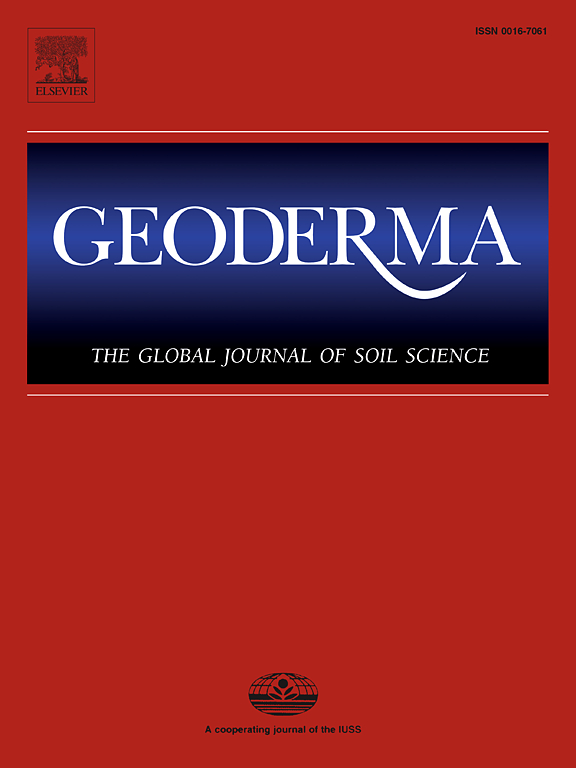基于多策略约束的青海湖和黑河流域多层剖面土壤水分时空估算与可转移性评价与改进
IF 5.6
1区 农林科学
Q1 SOIL SCIENCE
引用次数: 0
摘要
机器学习回归(MLR)算法为土壤水分估算提供了新的思路。然而,很少有研究探索MLR算法在多层和剖面SM建模中的潜力,以及它们的时空可移植性,这对实际部署和应用至关重要。本研究以双偏振c波段雷达数据为核心,在多源辅助数据(光学植被描述符、土壤性质和地形因子)约束下,构建多层和剖面的SM估计框架。在青海湖流域(QLB-NET)和黑河流域(WATERNET)两个新的SM观测网上进行了验证。结果表明,多输出多输入叠加策略回归(SSR)模型在多层和剖面SM估计中具有良好的时空可扩展性(RMSE = 0.027 ~ 0.044 cm3/cm3)和年际可转移性(RMSE = 0.031 ~ 0.055 cm3/cm3)。然而,SSR模型的跨空间传递精度较差(RMSE >;0.060立方厘米/立方厘米)。针对这一问题,提出了两种改进方案,重点关注原位观测数据的可及性。第一个涉及从目标域引入少量样本来更新SSR模型中的超参数。第二种方法利用散射模型的初始估计,即改进的变化检测模型来约束SSR模型,提高跨空间传递精度。两种方案均取得了满意的传输精度。在不同土壤深度下,前者可将SM估计误差分别降低40.8 ~ 72.8%和24.1 ~ 68.1%,后者可分别降低30.3 ~ 67.2%和22.4 ~ 68.8%。此外,还分析了影响遥感反演精度的因素,包括站差、遥感变率、植被覆盖度、土壤性质和成像轨道等。令人惊讶的是,由于时间变异性相对较低且对植被生产力敏感,大多数观测站深层(10-30 cm)的时空估计和传递精度优于表层(0-10 cm)。SSR模型在时空估计和迁移精度、运行效率和计算开销等方面均优于不同架构的深度学习算法。综上所述,本研究提出的框架为多层和剖面SM的遥感估算提供了新的视角和应用前景。本文章由计算机程序翻译,如有差异,请以英文原文为准。
Evaluation and improvement of spatiotemporal estimation and transferability of multi-layer and profile soil moisture in the Qinghai Lake and Heihe River basins using multi-strategy constraints
The machine learning regression (MLR) algorithms have brought new insights into soil moisture (SM) estimation. However, few studies have explored the potential of MLR algorithms for multi-layer and profile SM modeling, as well as their spatiotemporal transferability, which are important for practical deployment and application. In this study, the dual-polarization C-band radar data was used as the core to construct a multi-layer and profile SM estimation framework, constrained by multi-source auxiliary data (optical vegetation descriptors, soil properties, and terrain factors). Validation was carried out in two new SM observation networks: the Qinghai Lake basin (QLB-NET) and Heihe River basin (WATERNET). The results shown that the multi-output and multi-input stacking strategy regression (SSR) model demonstrated excellent spatiotemporal extensibility (RMSE = 0.027–0.044 cm3/cm3) and interannual transferability (RMSE = 0.031–0.055 cm3/cm3) in multi-layer and profile SM estimation. However, the cross-spatial transfer accuracy of the SSR model was poor (RMSE > 0.060 cm3/cm3). To address this, two improvement schemes were proposed, focusing on the accessibility of in-situ observation data. The first involved introducing a small number of samples from the target domain to update the hyperparameters in the SSR model. The second method used initial estimates from a scattering model, namely the modified change detection model, to constrain the SSR model and improve cross-spatial transfer accuracy. Both schemes achieved satisfactory transfer accuracy. The former strategy reduced SM estimation errors by 40.8–72.8 % and 24.1–68.1 % across various soil depths for two study areas, while the latter strategy achieved reductions of 30.3–67.2 % and 22.4–68.8 %, respectively. Additionally, factors influencing SM estimation and transfer accuracy were identified, including station difference, SM variability, vegetation cover, soil properties, and imaging orbits. Surprisingly, due to relatively low temporal variability and sensitive to vegetation productivity, the spatiotemporal estimation and transfer accuracy of deeper SM (10–30 cm) was better than that of surface SM (0–10 cm) at most observation stations. The SSR model outperformed deep learning algorithms of different architectures in terms of spatiotemporal estimation and transfer accuracy, operating efficiency, and computational overhead. In conclusion, the framework proposed in this study offers new perspectives and application prospects for remote sensing estimation of multi-layer and profile SM.
求助全文
通过发布文献求助,成功后即可免费获取论文全文。
去求助
来源期刊

Geoderma
农林科学-土壤科学
CiteScore
11.80
自引率
6.60%
发文量
597
审稿时长
58 days
期刊介绍:
Geoderma - the global journal of soil science - welcomes authors, readers and soil research from all parts of the world, encourages worldwide soil studies, and embraces all aspects of soil science and its associated pedagogy. The journal particularly welcomes interdisciplinary work focusing on dynamic soil processes and functions across space and time.
 求助内容:
求助内容: 应助结果提醒方式:
应助结果提醒方式:


